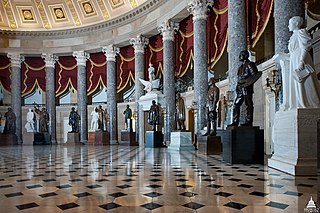
The National Statuary Hall is a chamber in the United States Capitol devoted to sculptures of prominent Americans. The hall, also known as the Old Hall of the House, is a large, two-story, semicircular room with a second story gallery along the curved perimeter. It is located immediately south of the Rotunda. The meeting place of the U.S. House of Representatives for nearly 50 years (1807–1857), after a few years of disuse in 1864 it was repurposed as a statuary hall; this is when the National Statuary Hall Collection was established. By 1933, the collection had outgrown this single room, and a number of statues are placed elsewhere within the Capitol.

Patrick Edward Connor was an American soldier who served as a Union general during the American Civil War. He is most notorious for his massacres against Native Americans during the Indian Wars in the American Old West.

Camp Douglas was established in October 1862, during the American Civil War, as a small military garrison about three miles east of Salt Lake City, Utah, to protect the overland mail route and telegraph lines along the Central Overland Route. In 1878, the post was renamed Fort Douglas. It was officially closed in 1991 pursuant to BRAC action and most of the property was turned over to the University of Utah. Many of the fort's buildings are preserved and used by the university for a variety of purposes. The Fort Douglas Military Museum is housed in two former barrack buildings, and a small section of the original post is still used by the U.S. Army Reserve. The fort was designated a National Historic Landmark in 1975, for its role in the Civil War and in furthering the settlement of Utah.
Bear Hunter (died January 29, 1863), "also known as Wirasuap " was a Shoshone chief of the Great Basin in the 1860s.

The Utah Territory during the American Civil War was far from the main operational theaters of war, but still played a role in the disposition of the United States Army, drawing manpower away from the volunteer forces and providing its share of administrative headaches for the Lincoln Administration. Although no battles were fought in the territory, the withdrawal of Union forces at the beginning of the war allowed the Native American tribes to start raiding the trails passing through Utah. As a result, units from California and Utah were assigned to protect against these raids. Mineral deposits found in Utah by California soldiers encouraged the immigration of non-Mormon settlers into Utah.
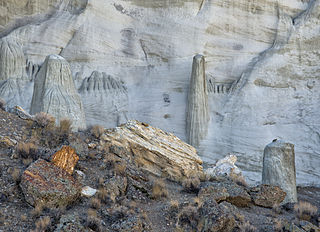
The Wahweap Formation of the Grand Staircase–Escalante National Monument is a geological formation in southern Utah and northern Arizona, around the Lake Powell region, whose strata date back to the Late Cretaceous. Dinosaur remains are among the fossils that have been recovered from the formation.
During the American Civil War in the early 1860s, the District of Utah was a subordinate district of the U.S. Army's Department of the Pacific. The district was composed of territorial areas that later became parts of the modern U.S. states of Idaho, Nevada, and Utah.
Talos is an extinct genus of carnivorous bird-like theropod dinosaur, an advanced troodontid which lived during the late Cretaceous period in the geographic area that is now Utah, United States.

Machairoceratops, previously known as the "Wahweap centrosaurine B", is an extinct genus of centrosaurine ceratopsian dinosaur known from the Late Cretaceous Wahweap Formation of Grand Staircase–Escalante National Monument, southern Utah, United States.

Brigham Dwaine Madsen was a historian of indigenous peoples of the American West, of the people of Utah and surrounding states, and of Mormonism. He was a professor at the University of Utah.
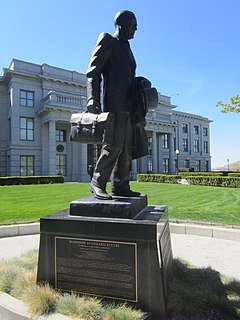
A bronze statue of Marriner S. Eccles by Mark DeGraffenried is installed outside the Utah State Capitol in Salt Lake City, in the U.S. state of Utah.

A statue of Thomas L. Kane by Ortho R. Fairbanks is installed outside the Utah State Capitol in Salt Lake City, in the U.S. state of Utah.

A bronze statue of Daniel C. Jackling by Avard Fairbanks is installed outside the Utah State Capitol in Salt Lake City, in the U.S. state of Utah.

The Edward Harriman Memorial is installed outside the Utah State Capitol in Salt Lake City, in the U.S. state of Utah.
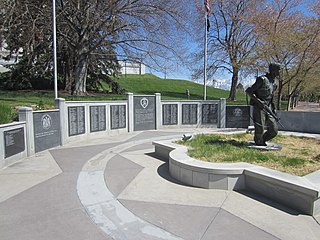
The Vietnam, Cambodia, and Laos Veterans Memorial is installed outside the Utah State Capitol in Salt Lake City, in the U.S. state of Utah. Dedicated on October 14, 1989, the memorial features a bronze statue of a soldier by Clyde Ross Morgan and a circular wall by Mark Davenport.
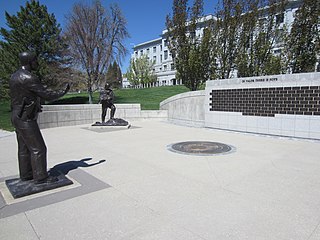
The Utah Law Enforcement Memorial by Lena Toritch is installed outside the Utah State Capitol in Salt Lake City, in the U.S. state of Utah.

Two pairs of lion sculpture are installed at the Utah State Capitol in Salt Lake City. The original statues were created by Gavin Jack with cement in 1915, and repaired by Ralphael Plescia in 1977. Replacements were sculpture by Nick Fairplay with Italian marble. The sculpture are known as Fortitude, Honor, Integrity, and Patience.

An eight ft (2.4 m) bronze sculpture of Vasilios Priskos by Daniel Fairbanks is installed in Salt Lake City, Utah, United States.

A statue of Eliza R. Snow is installed outside Salt Lake City's Pioneer Memorial Museum, in the U.S. state of Utah. The artwork commemorates pioneer women. The statue was sculpted by Mormon artist Ortho R. Fairbanks.

















